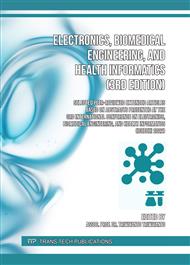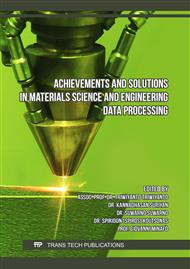[1]
K. Somasundaram and P. Kalavathi, ORIENTAL JOURNAL OF Analysis of Imaging Artifacts in MR Brain Images,, (2012).
Google Scholar
[2]
C. Science and S. Publications, Improving Diagnostic Viewing of Medical Images using Enhancement Algorithms Hanan Saleh S . Ahmed and Md Jan Nordin School of Computer Science , Faculty of Information Science and Technology ,, vol. 7, no. 12, p.1831–1838, (2011).
DOI: 10.3844/jcssp.2011.1831.1838
Google Scholar
[3]
D. Rochmayanti, T. S. Widodo, and I. Soesanti, Analisis Perubahan Parameter Number of Signals Averaged ( NSA ) Terhadap Peningkatan SNR dan Waktu Pencitraan pada MRI,, Jnteti, vol. 2, no. 4, p.37–45, (2013).
Google Scholar
[4]
J. Westbrook C, Carolyne ,K Roth dan Talbot, MRI in Practice, Fourth Edi. United Kingdom: Blackwell Science Ltd, (2011).
Google Scholar
[5]
G. W. Hashemi, H. Ray and Bradley, MRI : The Basic, Third. USA: Williams & Wilkins, (2010).
Google Scholar
[6]
A. N. dan T. P. R. 5. Bitar, Richard, General Leung, Richard Perng, Sameh Tadros, Alan R. Moody, Josee Sarrazin, Caitlin McGregor, Monique Christakis, Sean Symons, What Every Radiologist Wants to Know but Is Afraid to Ask, RSNA. volume 26. (2006).
DOI: 10.1148/rg.262055063
Google Scholar
[7]
W. A. Edelstein, M. Mahesh, and J. A. Carrino, MRI: Time is dose - And money and versatility,, J. Am. Coll. Radiol., vol. 7, no. 8, p.650–652, 2010,.
DOI: 10.1016/j.jacr.2010.05.002
Google Scholar
[8]
A. B. Susanto F, Santoso AG, Analisis Pembobotan T2 Turbo Spin Echo ( TSE ) Brain MRI Potongan Axial Dengan Penggunaan Sensitivity Encoding (SENSE) dan Tanpa Penggunaan SENSE : Evaluasi Pada Signal To Noise Ratio (SNR) dan Scan Time,, Jimed., vol. 2, no. 2, p.148–53, (2016).
DOI: 10.31983/jimed.v2i2.3174
Google Scholar
[9]
Elster; Allen D, Questions And Answers In Mri., http://www.mri-questions.com/senseasset.html (accessed Jan. 01, 2019).
Google Scholar
[10]
J. F. Glockner, H. H. Hu, D. W. Stanley, L. Angelos, and K. King, Parallel MR imaging: A user's guide,, Radiographics, vol. 25, no. 5, p.1279–1297, 2005,.
DOI: 10.1148/rg.255045202
Google Scholar
[11]
J. N. Morelli et al., An image-based approach to understanding the physics of MR artifacts,, Radiographics, vol. 31, no. 3, p.849–856, 2011,.
Google Scholar
[12]
G. JF, H. HH, S. DW, A. L, and K. K, Parallel MR imaging: a user's guide. Radiographics.,, vol. 25, no. 5, p.1279–1297, (2005).
Google Scholar
[13]
M. B. M. . B. dan R. C. Dale, MRI Basic Principle and Applications, Fifth. New Jersey.
Google Scholar
[14]
Y. J. F. J. A. D. Z. S. T. S. W. Y., Brain MR image denoising for Rician noise using pre-smooth non-local means filter,, vol. 14, p.1–20, 2015,.
DOI: 10.1186/1475-925x-14-2
Google Scholar
[15]
C. W. Ullah S, Ullah N, Ahmed I, Ahmad I, MRI Imaging , Comparison of MRI with other Modalities , Noise in MRI Images and Machine Learning Techniques for Noise Removal,, (2016).
DOI: 10.2174/1573405614666180726124952
Google Scholar
[16]
J. Mohan, V. Krishnaveni, and Y. Guo, A survey on the magnetic resonance image denoising methods,, Biomed. Signal Process. Control, vol. 9, no. 1, p.56–69, 2014,.
DOI: 10.1016/j.bspc.2013.10.007
Google Scholar
[17]
G. Chen, P. Zhang, Y. Wu, D. Shen, and P. T. Yap, Denoising magnetic resonance images using collaborative non-local means,, Neurocomputing, vol. 177, p.215–227, 2016,.
DOI: 10.1016/j.neucom.2015.11.031
Google Scholar
[18]
B. Priyadharsini, A Novel Noise Filtering Technique for Denoising MRI Images,, Int. J. Innov. Res. Comput. Commun. Eng., vol. 2, no. 1, p.2428–2433, (2014).
Google Scholar
[19]
S. Vaishali, K. K. Rao, and G. V. S. Rao, A review on noise reduction methods for brain MRI images,, Int. Conf. Signal Process. Commun. Eng. Syst. - Proc. SPACES 2015, Assoc. with IEEE, no. January, p.363–365, 2015,.
DOI: 10.1109/spaces.2015.7058284
Google Scholar
[20]
C. Anjanappa and H. S. Sheshadri, Denoising of Rician noise in Magnitude MRI Images using wavelet shrinkage and fusion method,, vol. 6, no. 5, p.54–63, 2016,.
Google Scholar
[21]
Kim DW; Kim C; Kim DH; Lim DH, Rician nonlocal means denoising for MR images using nonparametric principal component analysis,, 2011, p.1–8.
DOI: 10.1186/1687-5281-2011-15
Google Scholar
[22]
S. S. R. Balamurugan, Enhanced Nonlocal Mean Filter for MRI Denoising with Rician Noise," Int J Emerg Technol Adv Eng, vol. 4, no. 5, p.256–261, 2014, [Online]. Available: https://citeseerx.ist.psu.edu/viewdoc/download,doi=10.1.1.673.4518%5C&rep=rep1%5C&type=pdf.
Google Scholar
[23]
V. V. H. Snehal More, A Survey on Magnetic Resonance Image Denoising Methods,, Int. Res. J. Eng. Technol., vol. 03, no. 05, p.250–256, 2016, [Online]. Available: https://www.irjet.net/archives/V3/i5/IRJET-V3I554.pdf.
Google Scholar
[24]
J. Mohan, V. Krishnaveni, and Y. Guo, A survey on the magnetic resonance image denoising methods,, Biomed. Signal Process. Control, vol. 9, no. 1, p.56–69, 2014,.
DOI: 10.1016/j.bspc.2013.10.007
Google Scholar
[25]
Saryono and A. MD, Metodologi penelitian kualitatif dan kuantitatif dalam bidang kesehatan. Nuha Medika., (2013).
Google Scholar
[26]
S. S and I. S, Dasar dasar metodologi penelitian, Lima. (2014).
Google Scholar
[27]
Notoatmodjo, Metodologi Penelitian Kesehatan. Jakarta: PT. Rineka Cipta, (2002).
Google Scholar
[28]
M. Welvaert and Y. Rosseel, On the Definition of Signal-To-Noise Ratio and Contrast-To-Noise Ratio for fMRI Data,, vol. 8, no. 11, 2013,.
DOI: 10.1371/journal.pone.0077089
Google Scholar
[29]
D. ; Ryan, M; Cunningham, P; Cantwll, C; Brennan and S. Eustace, A comparison of fast MRI of hips with and without parallel imaging using SENSE,, Br. J. Radiol., (2005).
DOI: 10.1259/bjr/23825228
Google Scholar
[30]
A. T. Report, T., & Group, Parallel imaging in MRI : Technology , Applications , and Quality Control.,, (2015).
Google Scholar



